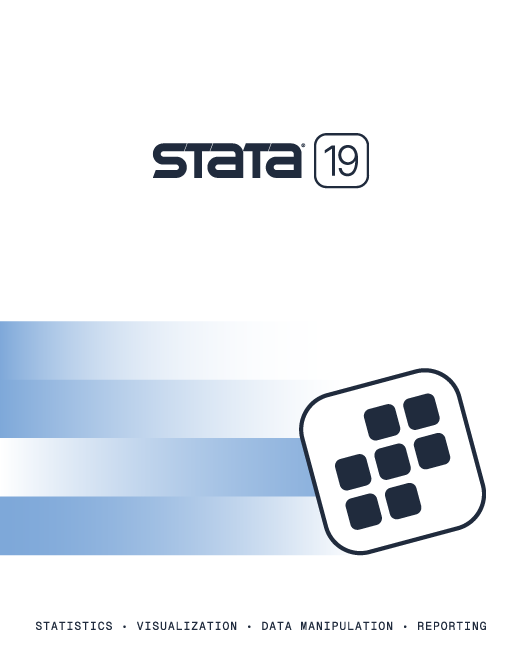

2025 Stata Conference • Nashville, TN • 31 July–01 August
Quantitative Data Analysis: Doing Social Research to Test Ideas |
||||||||||||||||||||||||||||||||||||||
 Click to enlarge See the back cover |

As an Amazon Associate, StataCorp earns a small referral credit from
qualifying purchases made from affiliate links on our site.
eBook not available for this title
eBook not available for this title |
|
||||||||||||||||||||||||||||||||||||
Comment from the Stata technical groupQuantitative Data Analysis, by Donald J. Treiman, is a well-written demonstration of how to answer questions using statistics. While the preface states that the book is “designed for a course to be taken after a first-year graduate statistics course in the social sciences”, the thought processes and techniques illustrated are useful and interesting to a much wider audience. The range of techniques is broad, ranging from simple advice for making tables readily readable through linear and logistic regression to log-linear and random-effects models. Treiman writes using clear, precise language. This style makes the book accessible to readers from many fields and especially worthwhile to statistical consultants or others who work with clients of different backgrounds. The book is highly applied—the examples stem from published papers with real datasets. Many of the examples stem from Treiman’s long history of research in applied sociology, yet these examples are still interesting and approachable to those outside the field. The main material is nicely supplemented with “callouts” containing biographical and historical background information, as well as tips on Stata usage. Treiman also takes the time and effort to explain how to avoid common pitfalls of data analysis. Because this is an applied book, there is little derivation of the mathematics behind the statistical techniques. This is not a drawback, though, because Treiman includes references and a large bibliography, which can be followed by those curious about statistical theory. Stata was used for the computation of all statistical results, and all the Stata do-files (Stata code) and datasets are available from the web. (In the book itself there is advice about how to use Stata for some analyses, but there is no explicit Stata code.) Quantitative Data Analysis is worth a look for those wanting to see the applications of a wide variety of statistical techniques to a variety of problems or for those who are interested in the thought process behind assessing the results of techniques. |
||||||||||||||||||||||||||||||||||||||
Table of contentsView table of contents >> Tables, Figures, Exhibits, and Boxes
Preface
The Author
Introduction
1 Cross-Tabulations
What This Chapter Is About
Introduction to the Book via a Concrete Example Cross-Tabulations What This Chapter Has Shown 2 More on Tables
What This Chapter Is About
The Logic of Elaboration Suppressor Variables Additive and Interaction Effects Direct Standardization A Final Note on Statistical Controls Versus Experiments What This Chapter Has Shown 3 Still More on Tables
What This Chapter is About
Reorganizing Tables to Extract New Information When to Percentage a Table “Backwards” Cross-Tabulations in Which the Dependent Variable is Represented by a Mean Index of Dissimilarity Writing About Cross-Tabulations What This Chapter Has Shown 4 On the Manipulation of Data by Computer
What This Chapter Is About
Introduction How Data Files Are Organized Transforming Data What This Chapter Has Shown Appendix 4.A Doing Analysis Using Stata
Tips on Doing Analysis Using Stata
Some Particularly Useful Stata 10.0 Commands 5 Introduction to Correlation and Regression (Ordinary Least Squares)
What This Chapter Is About
Introduction Quantifying the Size of a Relationship: Regression Analysis Assessing the Strength of a Relationship: Correlation Analysis The Relationship Between Correlation and Regression Coefficients Factors Affecting the Size of Correlation (and Regression) Coefficients Correlation Ratios What This Chapter Has Shown 6 Introduction to Multiple Correlation and Regression (Ordinary Least Squares)
What This Chapter is About
Introduction A Worked Example: The Determinants of Literacy in China Dummy Variables A Strategy for Comparisons Across Groups A Bayesian Alternative for Comparing Models Independent Validation What This Chapter Has Shown 7 Multiple Regression Tricks: Techniques for Handling Special Analytic Problems
What This Chapter Is About
Nonlinear Transformations Testing the Equality of Coefficients Trend Analysis: Testing the Assumption of Linearity Linear Splines Expressing Coefficients as Deviations from the Grand Mean (Multiple Classification Analysis) Other Ways of Representing Dummy Variables Decomposing the Difference Between Two Means What This Chapter Has Shown 8 Multiple Imputation of Missing Data
What This Chapter Is About
Introduction A Worked Example: The Effect of Cultural Capital on Educational Attainment in Russia What This Chapter Has Shown 9 Sample Design and Survey Estimation
What This Chapter Is About
Survey Samples Conclusion What This Chapter Has Shown 10 Regression Diagnostics
What This Chapter Is About
Introduction A Worked Example: Societal Differences in Status Attainment Robust Regression Bootstrapping and Standard Errors What This Chapter Has Shown 11 Scale Construction
What This Chapter Is About
Introduction Validity Reliability Scale Construction Errors-in-Variables Regression What This Chapter Has Shown 12 Log-Linear Analysis
What This Chapter Is About
Introduction Choosing a Preferred Model Parsimonious Models A Bibliographic Note What This Chapter Has Shown Appendix 12.A Derivation of the Effect Parameters
Appendix 12.B Introduction to Maximum Likelihood Estimation
Mean of a Normal Distribution
Log-Linear Parameters 13 Binomial Logistic Regression
What This Chapter Is About
Introduction Relation to a Log-Linear Analysis A Worked Logistic Regression Example: Predicting Prevalence of Armed Threats A Second Worked Example: Schooling Progression Ratios in Japan A Third Worked Example (Discrete-Time Hazard-Rate Models): Age at First Marriage A Fourth Worked Example (Case–Control Models): Who Was Appointed to a Nomenklatura Position in Russia? What This Chapter Has Shown Appendix 13.A Some Algebra for Logs and Exponents
Appendix 13.B Introduction to Probit Analysis
14 Multinomial and Ordinal Logistic Regression and Tobit Regression
What This Chapter Is About
Multinomial Logit Analysis Ordinal Logistic Regression Tobit Regression (and Allied Procedures) for Censored Dependent Variables Other Models for the Analysis of Limited Dependent Variables What This Chapter Has Shown 15 Improving Causal Inference: Fixed Effects and Random Effects Modeling
What This Chapter Is About
Introduction Fixed Effects Models for Continuous Variables Random Effects Models for Continuous Variables A Worked Example: The Determinants of Income in China Fixed Effects Models for Binary Outcomes A Bibliographic Note What This Chapter Has Shown 16 Final Thoughts and Future Directions: Research Design and Interpretation Issues
What This Chapter Is About
Research Design Issues The Importance of Probability Sampling A Final Note: Good Professional Practice What This Chapter Has Shown Appendix A: Data Descriptions and Download Locations for the Data Used in This Book
Appendix B: Survey Estimation with the General Social Survey
References
Index
|
||||||||||||||||||||||||||||||||||||||
Learn
Free webinars
NetCourses
Classroom and web training
Organizational training
Video tutorials
Third-party courses
Web resources
Teaching with Stata
© Copyright 1996–2025 StataCorp LLC. All rights reserved.
×
We use cookies to ensure that we give you the best experience on our website—to enhance site navigation, to analyze usage, and to assist in our marketing efforts. By continuing to use our site, you consent to the storing of cookies on your device and agree to delivery of content, including web fonts and JavaScript, from third party web services.
Cookie Settings
Last updated: 16 November 2022
StataCorp LLC (StataCorp) strives to provide our users with exceptional products and services. To do so, we must collect personal information from you. This information is necessary to conduct business with our existing and potential customers. We collect and use this information only where we may legally do so. This policy explains what personal information we collect, how we use it, and what rights you have to that information.
These cookies are essential for our website to function and do not store any personally identifiable information. These cookies cannot be disabled.
This website uses cookies to provide you with a better user experience. A cookie is a small piece of data our website stores on a site visitor's hard drive and accesses each time you visit so we can improve your access to our site, better understand how you use our site, and serve you content that may be of interest to you. For instance, we store a cookie when you log in to our shopping cart so that we can maintain your shopping cart should you not complete checkout. These cookies do not directly store your personal information, but they do support the ability to uniquely identify your internet browser and device.
Please note: Clearing your browser cookies at any time will undo preferences saved here. The option selected here will apply only to the device you are currently using.